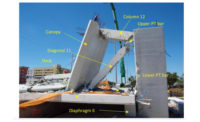Navillus Settles Into Normal Business Life After One-Year Bankruptcy

Image: Navillus
Trouble appears to be over between Navillus, one of New York City’s biggest contractors, and five building trades unions.
Navillus sought bankruptcy protection 14 months ago after a federal judge ordered it to pay $76 million to union pension and benefit funds. The unions, with which the contractor had agreements, successfully sued the company in 2014. They claimed Navillus violated federal pension law, collective bargaining agreements and commitment to work union through two separate nonunion companies, one of which, Advanced Contracting Solutions (ACS), had ties to Navillus’ owner and president, Donal O’Sullivan.
After the judge’s payment order, the unions attempted to freeze all the contractor’s bank accounts through restraining notices, and Navillus and ACS sought bankruptcy protection.
Navillus says it is proud to continue in business as one of New York City’s biggest union employers—no small thing at a time when building trades unions are fighting to maintain their stature in the city.
Navillus, which performs much concrete construction as both prime contractor and subcontractor, steadfastly claims in a statement that it "never operated a non-union company and consistently disputes any allegations that they did."
The parties to both the civil lawsuit by the unions and the contractor's bankruptcy used mediation to reach a settlement and vacate the judgement and decision against Navillus.
So far, union officials have not commented publicly. One reason that unions may have agreed to take only $25 million—about one third of what a lower federal court had originally ordered Navillus to pay in 2017—might be explained by the words of a U.S. federal appeals court judge who vacated the order after Navillus' appeal.
“This will keep one of New York City’s largest construction contractors in business," wrote Judge Colleen McMahon. 'It will protect dozens of ongoing projects from disruption, preserve numerous union jobs and provide continuing benefit to the plaintiff funds, and all of Navillus’ stakeholders.”
Navillus says it kept working on its projects, including two prominent Manhattan towers for which it was constructing concrete frames before emerging from Chapter 11 [of the federal bankruptcy code] last October. The uninterrupted effort “was a testament to the belief and trust that clients have in Navillus,” the company said. Since the settlement, Navillus has been adding to its backlog.
Founded in 1987 as Navillus Tile, the company branched out from tile and masonry to concrete. It has been a force in the city’s construction marketplace.
At the time of the bankruptcy, the company had 640 union employees and 65 management-level staff. According to Navillus’ attorney’s statements to the bankruptcy judge, the company had an average annual gross income of $180 million, but 2016 gross income of $240 million. Its current cash and marketable securities at the time equaled $20.8 million, $12.2 million of which was cash. Its receivables were $55.3 million and it owed $13 million.
O’Sullivan’s main concern through the turmoil was the company’s employees and hundreds of union workers, the company’s statement said. Navillus also indicated it was proud to continue in business as one of New York City’s biggest union employers—no small thing at a time when building trades unions are fighting to maintain their stature in the city.
The regional building trades council is battling one of the city’s biggest developers, The Related Cos., over the next phase of its Hudson Yards project. Related wants to bargain with the unions on a one-on-one basis. And several unions in recent years have adopted what is
essentially is a tiered wage system—
another concession to their eroding bargaining power and market share.
Financing Operations
Navillus said it was almost able to finance all of its own operations while in bankruptcy. Although the contractor’s surety, Liberty Mutual, provided a $20-million debtor-in-possession financial facility at a 3% interest rate, with no default rate and no fees, none of the DIP loan was used. After the DIP loan ended and Navillus emerged from bankruptcy, Liberty Mutual partially financed the settlement.Only a small number of Navillus creditors were forced to take reduced payments, the company also stated.
But the litigation isn’t over. Navillus is back in federal court, this time as a plaintiff seeking in new lawsuits several million dollars from several of the city’s biggest general contractors and New York City’s Dept. of Environmental Protection. The contractor claims in some of the lawsuits that the prime contractors and DEP are improperly withholding retained funds held back when it filed for bankruptcy protection. Other lawsuits, the company stated, began before its bankruptcy filing.
Portions and details of this story were corrected Jan. 11 to show that no financing from surety Liberty Mutual is currently needed by Navillus and that only a small amount was used after Navillus' bankruptcy. Corrections also clarified other aspects of the bankruptcy and civil lawsuit claim and settlement and the financial details about Navillus prior to the bankruptcy.




